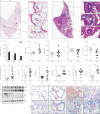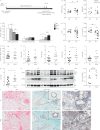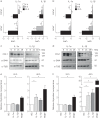IL-1 receptor blockade skews inflammation towards Th2 in a mouse model of systemic sclerosis
- PMID: 31320452
- PMCID: PMC6860995
- DOI: 10.1183/13993003.00154-2019
IL-1 receptor blockade skews inflammation towards Th2 in a mouse model of systemic sclerosis
Abstract
The interleukin (IL)-1 family of cytokines is strongly associated with systemic sclerosis (SSc) and pulmonary involvement, but the molecular mechanisms are poorly understood. The aim of this study was to assess the role of IL-1α and IL-1β in pulmonary vascular and interstitial remodelling in a mouse model of SSc.IL-1α and IL-1β were localised in lungs of SSc patients and in the fos-related antigen-2 (Fra-2) transgenic (TG) mouse model of SSc. Lung function, haemodynamic parameters and pulmonary inflammation were measured in Fra-2 TG mice with or without 8 weeks of treatment with the IL-1 receptor antagonist anakinra (25 mg·kg-1·day-1). Direct effects of IL-1 on pulmonary arterial smooth muscle cells (PASMCs) and parenchymal fibroblasts were investigated in vitroFra-2 TG mice exhibited increased collagen deposition in the lung, restrictive lung function and enhanced muscularisation of the vasculature with concomitant pulmonary hypertension reminiscent of the changes in SSc patients. Immunoreactivity of IL-1α and IL-1β was increased in Fra-2 TG mice and in patients with SSc. IL-1 stimulation reduced collagen expression in PASMCs and parenchymal fibroblasts via distinct signalling pathways. Blocking IL-1 signalling in Fra-2 TG worsened pulmonary fibrosis and restriction, enhanced T-helper cell type 2 (Th2) inflammation, and increased the number of pro-fibrotic, alternatively activated macrophages.Our data suggest that blocking IL-1 signalling as currently investigated in several clinical studies might aggravate pulmonary fibrosis in specific patient subsets due to Th2 skewing of immune responses and formation of alternatively activated pro-fibrogenic macrophages.
Copyright ©ERS 2019.
Conflict of interest statement
Conflict of interest: A. Birnhuber reports grants from Jubilee Foundation of the Austrian National Bank, during the conduct of the study. Conflict of interest: S. Crnkovic has nothing to disclose. Conflict of interest: V. Biasin has nothing to disclose. Conflict of interest: L.M. Marsh has nothing to disclose. Conflict of interest: B. Odler has nothing to disclose. Conflict of interest: A. Sahu-Osen has nothing to disclose. Conflict of interest: E. Stacher-Priehse has nothing to disclose. Conflict of interest: L. Brcic reports grants and personal fees from AstraZeneca, personal fees from Roche Austria, nonfinancial support from MSD Austria and Pfizer Austria, outside the submitted work. Conflict of interest: F. Schneider has nothing to disclose. Conflict of interest: N. Cikes has nothing to disclose. Conflict of interest: B. Ghanim has nothing to disclose. Conflict of interest: W. Klepetko has nothing to disclose. Conflict of interest: W. Graninger has nothing to disclose. Conflict of interest: Y. Allanore has nothing to disclose. Conflict of interest: R. Eferl has nothing to disclose. Conflict of interest: A. Olschewski has nothing to disclose. Conflict of interest: H. Olschewski reports personal fees and nonfinancial support from Bayer, MSD, Pfizer and Novartis, grants, personal fees and nonfinancial support from Actelion, grants from Inventiva, personal fees from Bellerophon, outside the submitted work; and is a part-time employee of the Ludwig Boltzmann Institute for Lung Vascular Research, Graz, Austria. Conflict of interest: G. Kwapiszewska reports grants from Jubilee Foundation of the Austrian National Bank (grant 16187), Austrian Science Fund (FWF) (P27848-B28), and Austrian Agency for International Cooperation in Education and Research (WTZ HR14/2012), during the conduct of the study.
Figures






References
-
- Elhai M, Meune C, Boubaya M, et al. . Mapping and predicting mortality from systemic sclerosis. Ann Rheum Dis 2017; 76: 1897–1905. - PubMed
-
- Giacomelli R, Liakouli V, Berardicurti O, et al. . Interstitial lung disease in systemic sclerosis: current and future treatment. Rheumatol Int 2017; 37: 853–863. - PubMed
-
- Gu YS, Kong J, Cheema GS, et al. . The immunobiology of systemic sclerosis. Semin Arthritis Rheum 2008; 38: 132–160. - PubMed
Publication types
MeSH terms
Substances
Grants and funding
LinkOut - more resources
Full Text Sources
Other Literature Sources
Medical
Miscellaneous
